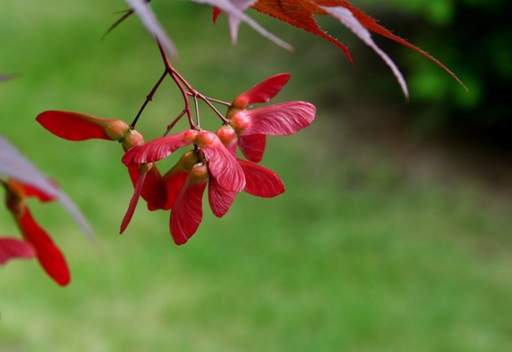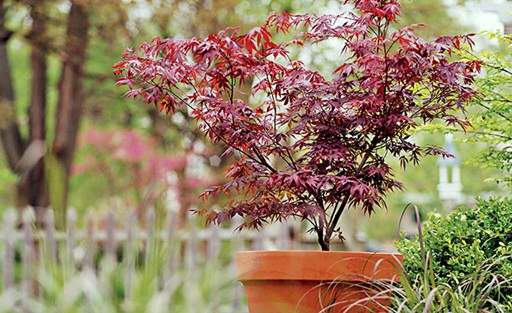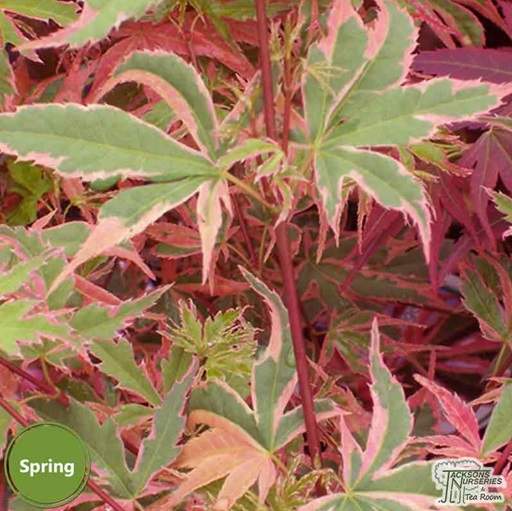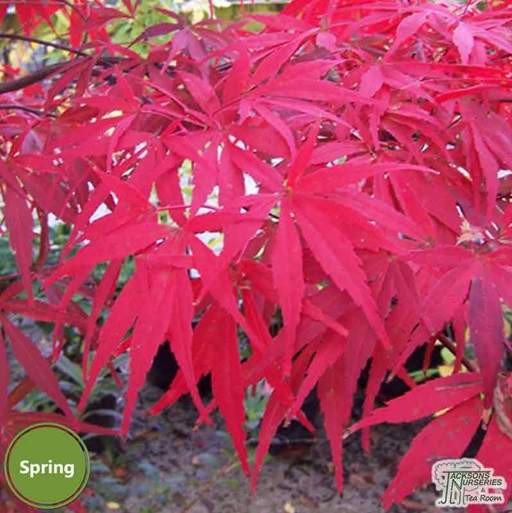Guide to Japanese Maple Trees
Japanese Maples are small, deciduous trees best known for their elegant, architectural form and stunning autumn foliage colours. They are generally slow growing and come in varying forms such as weeping, upright and spreading. Like all maple trees, Japanese Acers have lobed foliage with veins spreading out like the fingers of a hand. However, the leaves are smaller than traditional maples and many varieties have deeply dissected, almost feathery leaves that might not be immediately recognised as a maple tree. Japanese Acers are native to the hills and forest fringes of Japan, Korea and Mongolia where they grow in the shade of larger trees on woodland fringes, which makes them more shade-tolerant than other deciduous trees. Their natural habitat is out of strong winds, with some light shade and normally a neutral to acidic, moist but free-draining soil.
Despite being deciduous, Japanese maples add beauty and interest to the garden all year round. As well as producing small flowers in spring, many trees also boast remarkable spring foliage colours when the leaves start to clothe the tree again in March-April. Small twirling seeds or "keys" spin down to the ground like miniature helicopters in the autumn. Their clever shape means they descend slowly and can be carried aloft by the wind, allowing them to be dispersed over greater distances. Even when the leaves fall in the autumn, the silhouette of the intricate branches leaves plenty to marvel at over the winter. There are over 1,000 different cultivars, so you'll have plenty of leaf colours, shapes and sizes to choose from.

Uses of Japanese Maples
- Japanese Acers are perfect for growing in patio containers or planters. This allows your tree to be taken to a more prominent location during times of seasonal interest and to adjust the amount of sunlight it receives. Young trees don't require a large pot, but remember smaller containers will require frequent watering, especially in summer.
- Dome-forming and cascading trees are best planted at the top of a slope or wall or next to water, which will show off their beauty much better than planting on flat ground. They also look striking in small groupings if space allows.

- Prostrate and low-growing trees are ideal for smaller gardens and under-planting larger trees. They will succeed beneath evergreen trees on the north or east-facing side where they can still catch some sun, but the continuous shade directly beneath dense evergreens is not ideal. Under-planting below pine trees or other varieties with narrow or needle-like foliage that allows some dappled sunlight to filter through make good locations.
- The stately form of upright varieties makes them perfect for using as feature trees or specimens, which also suits their requirements as the shallow, spreading fibrous root systems doesn't cope well with nearby competition.

- Their Far Eastern "feel" makes them well suited to Japanese-themed plantings. Having said this, they can fit into virtually any garden style and combine well with other shade-loving plants such as Holly, Rhododendrons and Azaleas in the border, so don't think you have to have the "right" type of garden.
- Finally, Japanese Maples make the ideal subjects for the ancient Japanese and Chinese art of bonsai, which uses living trees to create objects that can grace a dining table or terrace. Bonsai plants are often displayed in Japanese houses in special niches for interesting objects. Any prostrate variety can be used for bonsai but it takes time and requires some specialist knowledge.

Different types of Japanese Maple tree
There are three main types of Japanese Acer, each with their own distinct characteristics:
- Acer palmatum - native to the forests of Korea and China and have been cultivated in Japan for over three hundred years. Named 'palmatum' because the leaves look like a hand, whilst the Japanese name momiji means the hand of a baby. Most are small, deciduous trees grown for their graceful habit and beautiful foliage colour. Many cultivars are extremely slow growing, making them perfect for small gardens or for growing in pots, but check the eventual height/spread before buying as there are a few that grow taller.
- Acer japonicum- also known as the Amur maple, this is a species native to Japan and south Korea. They tend to be more cold hardy than other Japanese maples and are ideal for bringing an architectural presence to the garden. Japonicums are low maintenance, shallow rooting trees with slender shoots that have slight whitish hairs. The foliage is serrated and lobed but not as deeply dissected as some of the palmatum varieties.
- Acer shirasawanum- a species from southern Japan closely related to and sometimes included as a sub-species of Acer Japonicum. However, it is distinct due to its hairless shoots and usually smaller leaves. Tends to grow taller than other Japanese maples with an eventual height of 8 to 15 metres and trunk diameter of around 50cm depending on location, making them well suited to larger gardens.
Acer palmatum tends to be the best for ornamental purposes. If you're unsure which variety to go for, feel free to contact a member of our team - we'll be happy to help.

Best position for Japanese Maples
- Above all, Japanese Acers require a sheltered position away from strong northerly winds and frost pockets. Acer palmatum dissectum cultivars in particular have a low tolerance to windy conditions.
- They will grow in most soils except very dry, waterlogged or alkaline conditions. A moist yet well-drained, slightly acidic loam rich in organic matter is ideal. Other soils can be enriched with ericaceous compost when planting.
- Partial or dappled shade is required for variegated varieties to prevent the leaves from being scorched by the strong afternoon sun. Purple and red leaved trees require a decent amount of sunlight to develop their rich, dark complexion, whilst green-leaved Acers tolerate full sun but do best with light shade at the hottest part of the day.
- Avoid planting Japanese maples too close together as their shallow, spreading fibrous root system doesn't cope well with nearby competition.
- If your Japanese Maple doesn't seem to be succeeding after a couple of years, don't be afraid to dig it up and try moving it somewhere else. Location is probably the most important factor in the success of your tree, so don't be afraid of a bit of trial and error. The best time to move a Japanese maple tree is late summer or early autumn, at least one month before the first frost. They are reasonably forgiving of disruption providing you cut a wide and deep hole and leave as much soil clinging to the roots as possible when you dig them up.

Our Recommendation - the best Japanese Acer Trees
Acer palmatum 'Aratama' - a beautiful, truly dwarf compact deciduous Japanese Acer with a stunning seasonal change in foliage that turns from brick red in spring, through to dark olive green in summer and then orange-red in autumn. Fantastic for pots, planters and on the edge of the patio or rockery.
Acer palmatum 'Atropurpureum' - a beautiful, small deciduous cultivar, bearing the most attractive, deep burgundy maple shaped leaves. In winter the foliage turns a really bright scarlet. Tiny purple flowers appear in spring time on mature specimens, often followed by winged, purple fruits. 'Atropurpureum' can be grown in a large tub, or in the back of the border to form a large shrub or small tree that won't overgrow the garden. Leaf colouring is best in partial shade. Can tolerate full sun but leaves may get a little scorched.

Acer palmatum 'Beni-komachi' - translates to ‘Red Beautiful Little Girl’, which is certainly very fitting for this beautiful dwarf variety of acer. Reaching around two metres at full maturity, this attractive tree will add a beautiful, vibrant splash of colour to any garden.
Acer palmatum 'Beni-Maiko' - a dwarf variety of deciduous Japanese Maple with brilliant fiery red colours. Foliage has a crinkled appearance, opening bright red in spring time, fading to reddish-pink, then green in the summer, followed by blazing red in the autumn. Grows well in a large tub or planter, and is ideal for creating a Japanese theme anywhere in your garden.

Acer palmatum 'Beni-shichihenge' - a beautiful, very unusual upright Japanese deciduous Acer. Leaves are green in the centre, with contrasting shrimp pink and orange margins. A superb dwarf compact tree ideal for the edge of patios and to add structure without taking over smaller gardens.

Acer palmatum 'Bloodgood' - a wonderful, small deciduous tree with great ornamental value and refined beauty. It has palmate, deep purple leaves and produces long-lasting, red-purple fruits in clusters in the autumn, just as the foliage is starting to take on brilliant shades of crimson. It has an erect growth habit that is set off well against a deeply coloured backdrop and produces small, dark red flowers in the spring. Makes a perfect specimen tree for a sunny, sheltered position in a small garden.

Acer palmatum 'Burgundy Lace'- a medium sized, spreading deciduous Acer with young, finely cut light red-purple leaves in the spring, later darkening to a deep green with fantastic fiery purple and scarlet autumn hues. 'Burgundy Lace' makes an ideal small tree to grow in a tub or for creating a Japanese feel in borders and rockeries. Prefers partial shade. Can tolerate full sun but leaves may get a little scorched.

Acer palmatum 'Fireglow' - one of the best deciduous Japanese Acers for colour and all-round interest. Brilliant red leaves through summer, turning deep rich scarlet and crimson in autumn. Beautiful and striking on its own in the border, as part of a rockery feature, or in a large tub on the patio. Perfect for creating a Japanese feel in any garden.

Acer palmatum 'Kagiri-nishiki' - a strong but slow growing, variegated acer with beautiful bluish-green leaves which are margined in light pink tones and streaked with white. It has a dainty appearance and will make a lovely addition to any autumn garden as it adds interest in the cooler months.

Acer palmatum 'Katsura' - a truly spectacular Japanese Acer, with foliage interest throughout the seasons. New spring foliage of pale orange, turning then to warm yellows edged with pinky-orange hues before changing yet again to a bright green colour in summer. Autumn brings another change as the leaves then turn back to rich orange colours. A stunning small deciduous tree or large shrub that would make an eye-catching centre piece in your garden.

Acer palmatum 'Orange Dream' - a slow growing deciduous Acer with beautiful golden yellow-orange spring growth turning limey-green for the summer then a stunning orange gold in the autumn. Suitable for all but the hottest parts of the garden, where the foliage is liable to scorch in the strong midsummer sun. Ideal for small gardens or large containers. Perfect in semi-shade in good, rich soil where it will make an impressive specimen plant. Water well until established to ensure a strong, healthy plant.

Acer palmatum 'Oregon Sunset' - a small, slow growing deciduous Acer shrub with a rounded shape. Ideal for smaller gardens or as a container plant, its beautiful red leaves take on an orange tone in autumn, providing interesting colour contrasts.
Acer palmatum 'Sango-Kaku' - a large, slow-growing deciduous Acer, with coral-red young branches bearing lobed leaves which open pinkish-yellow, maturing to bright green in the summer, and golden yellow in the autumn. Small red flowers often appear in spring/summer. Excellent for providing year round interest. Leaf colour is best in partial shade, with dappled sunlight. No routine pruning required.

Acer palmatum 'Shaina' - a medium sized compact deciduous Acer, with an upright growth habit. Fantastic bright red spring leaves turn a brilliant dark red in summer, followed by bright crimson in autumn. It will grow to form a dense and compact globe of small red foliage - a slow growing Japanese maple that is an ideal selection for containers or small gardens. Prefers partial shade, but can tolerate full sun, as long as the plant is shaded for a small part of the day.

Acer palmatum 'Shirazz' - also known as Gwen's Rose Delight, this is an extremely eye catching Japanese Acer as it has deeply lobed, variegated deciduous leaves of reddish-purple with bright reddish-pink margins in spring, turning grey-green with cream and pink margins in summer, and shades of scarlet in autumn. Upright in habit, though it has slightly arching graceful red branches. Ideal for containers or tubs, or as a focal point in a border. Prefers partial shade, but can tolerate full sun.
Acer palmatum 'Wilson's Pink Dwarf' - stunning deciduous foliage, young bright pink leaves in spring turn green with yellow tones, and then bright red to orange in autumn. Made all the more striking as they show on the green background of older leaves. The size of this Acer makes it suitable for many gardens, perfect for growing in containers. Prefers partial shade, but can tolerate full sun.
Acer palmatum dissectum 'Baldsmith' - a handsome acer with a mounded form, with lacy leaves which emerge bright orange/red and develop into shades of green, pink and orange through the summer months. The combination of old and new leaves adorning the branches throughout summer makes for a beautiful rainbow of colour, adding spectacular interest to any garden.

Acer palmatum dissectum 'Crimson Princess' - a deciduous Acer has an upright weeping habit, creating a mushroom like display. Finely cut, fabulous deep purple-red leaves emerge from red buds turning bronze in the summer, followed by brilliant crimson-scarlet in autumn.

Acer palmatum dissectum 'Garnet' - a beautiful eye-catching mound-forming deciduous shrub with red-purple foliage turning fiery red in autumn. 'Garnet' has arching shoots, and bears purple flowers in spring and red fruits in summer. It is a slow growing variety, making it a good choice for small gardens or large containers. Leaf colour is best in partial shade, but it can tolerate full sun, however, leaf scorch may occur.

Acer palmatum dissectum 'Orangeola' - a beautiful, mound-forming deciduous Acer has blazing orange red lace leaves throughout spring, turning bronze red in summer, then deep and fiery orange in autumn. Small, pendent clusters of tiny, reddish-purple flowers in spring are followed by red-flushed, green, winged fruit in summer. A beautiful Japanese Acer, eye catching and weeping - a stunning small architectural tree, ideal as a centre piece for your garden.

Acer palmatum dissectum 'Viridis' - a beautiful low growing weeping deciduous Acer that forms a mound habit. The feathery foliage is a bright lime green throughout the spring and summer before turning shades of red, orange and gold in the autumn. Acid soil will ensure the best autumn colour although lime can be tolerated. Prefers partial shade, but can tolerate full sun. Ideal for planters, or for creating a focal point in a border.

Acer palmatum dissectum 'Tamukeyama' - a truly eye catching deciduous Acer with a mound-forming, weeping habit, and spreading nature. Slow growing, new spring growth is deep crimson, turning a vibrant purple-red in the summer, followed by fiery scarlet in the autumn. Perfect for planters or containers, or for creating a focal point in a border. More tolerant of full sun than some other Acers.

-
Plant Guides
- Guide to Bamboo Plants
- Guide to Climbing Plants
- Guide to Climbing Roses
- Guide to Conifers
- Guide to Floribunda Roses
- Guide to Fruit Bushes
- Guide to Fruit Trees
- Guide to Garden Ferns
- Guide to Garden Shrubs
- Guide to Heather Plants
- Guide to Hedging Plants
- Guide to Herb Plants
- Guide to Herbaceous Perennials
- Guide to Hybrid Tea Roses
- Guide to Japanese Maple Trees
- Guide to Ornamental Grasses
- Guide to Rhododendrons
- Guide to Topiary
Share this page:







